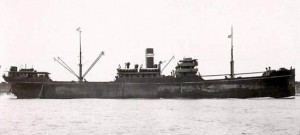 The SS Gairsoppa, a British cargo steamship that was enlisted by the UK Ministry of War Transport to do its cargo runs, was sunk by a German U-boat torpedo on February 17, 1941, in the North Atlantic about 300 miles west of Ireland. It had been loaded in Calcutta with an immense load of commodities — 2,600 tons of pig iron, 1,765 tons of tea, 220 tons of silver ingots — headed for Liverpool. A merchant vessel built in 1919 for the British India Steam Navigation company, the Gairsoppa was unable to withstand the attack. That one torpedo blasted a hole in the hull and took down the foremast, severing all the radio cables and leaving the ship unable to communicate a distress call. The ship sank in just 20 minutes, taking its valuable cargo with it.
The SS Gairsoppa, a British cargo steamship that was enlisted by the UK Ministry of War Transport to do its cargo runs, was sunk by a German U-boat torpedo on February 17, 1941, in the North Atlantic about 300 miles west of Ireland. It had been loaded in Calcutta with an immense load of commodities — 2,600 tons of pig iron, 1,765 tons of tea, 220 tons of silver ingots — headed for Liverpool. A merchant vessel built in 1919 for the British India Steam Navigation company, the Gairsoppa was unable to withstand the attack. That one torpedo blasted a hole in the hull and took down the foremast, severing all the radio cables and leaving the ship unable to communicate a distress call. The ship sank in just 20 minutes, taking its valuable cargo with it.
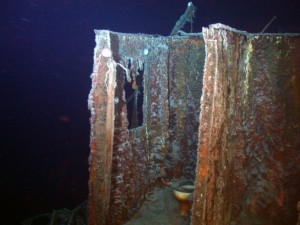 The 85-member crew sadly did not survive. Many of them made it to the lifeboats even under German machine gun fire, but then two of the three lifeboats capsized in the rough waters. The final lifeboat made it to the Cornwall shore 13 days later, but it too capsized while drifting along the coast and only one survivor was fished out: Second Officer R.H. Ayres, who received many awards for his bravery in trying to save his fellow passengers. (He lived a long life and passed away in 1992.)
The 85-member crew sadly did not survive. Many of them made it to the lifeboats even under German machine gun fire, but then two of the three lifeboats capsized in the rough waters. The final lifeboat made it to the Cornwall shore 13 days later, but it too capsized while drifting along the coast and only one survivor was fished out: Second Officer R.H. Ayres, who received many awards for his bravery in trying to save his fellow passengers. (He lived a long life and passed away in 1992.)
In 1989, the British government attempted a salvage operation to recover the precious metals that sank on the Gairsoppa. The company who won the salvage contract also happened to be the only company that made a bid. It was unable to find the wreck.
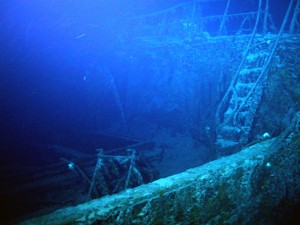 The government tried again last year and this time the winning bidder was Odyssey Marine Exploration, a US treasure hunting firm that is known for big finds (and big legal entanglements). It’s quite the sweet contract. Odyssey gets to keep 80% of the net value of all the silver bullion found. That’s net, so obviously their expenses get paid first. At today’s prices, the silver could be worth as much as $210 million, which would make this haul the largest precious metal hoard ever found at sea.
The government tried again last year and this time the winning bidder was Odyssey Marine Exploration, a US treasure hunting firm that is known for big finds (and big legal entanglements). It’s quite the sweet contract. Odyssey gets to keep 80% of the net value of all the silver bullion found. That’s net, so obviously their expenses get paid first. At today’s prices, the silver could be worth as much as $210 million, which would make this haul the largest precious metal hoard ever found at sea.
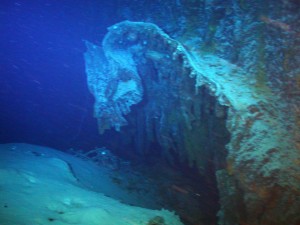 Using data from the previous failed expedition plus extensive new research on where the wreck might be located, Odyssey was able to pinpoint the proper search area. They were then able to locate a likely wreck using a deep-tow low frequency sonar system. A remotely operated vehicle relayed video and photographic confirmation that this not just a likely wreck but the actual wreck of the SS Gairsoppa sitting upright nearly 4,700 meters below the surface of the North Atlantic.
Using data from the previous failed expedition plus extensive new research on where the wreck might be located, Odyssey was able to pinpoint the proper search area. They were then able to locate a likely wreck using a deep-tow low frequency sonar system. A remotely operated vehicle relayed video and photographic confirmation that this not just a likely wreck but the actual wreck of the SS Gairsoppa sitting upright nearly 4,700 meters below the surface of the North Atlantic.
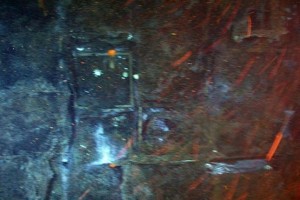 Although the robot was unable to locate those tons of silver or something bearing the ship name, all the facts fit. The ship is the proper length, width and height; the torpedo damage matches the description in the German U-boat logs; stacks of tea chests were found, the proper number of cargo holds and derricks, the proper ship layout, even the same hull colors.
Although the robot was unable to locate those tons of silver or something bearing the ship name, all the facts fit. The ship is the proper length, width and height; the torpedo damage matches the description in the German U-boat logs; stacks of tea chests were found, the proper number of cargo holds and derricks, the proper ship layout, even the same hull colors.
Odyssey is now putting together the necessary tools and equipment for a salvage operation 4,700 meters under the sea. The Gairsoppa did them a huge favor by landing on its feet, so all the cargo holds are open and accessible. The salvage crew will use them to unload the silver just like any stevedore would topside. Operations will begin next Spring in more propitious weather conditions.
[youtube=http://www.youtube.com/watch?v=Ehoaap6aRVY&w=430]
Sweet contract indeed. I am in the wrong business!
Yeah, hunting historical treasure on the high seas turns out to be a sweet gig. Who knew?
It will be interesting to see what kind of submarine they use for the recovery. They certainly won’t be sending down recreational divers to 4,700 meters under the sea. That’s 15,419 feet! Other deep dives include the bathyscaph Trieste, which in 1963 explored the site of the sunken nuclear-powered submarine Thresher at 8400 feet; in 1986, mini sub Alvin carried Robert Ballard down to the famous Titanic at 13,000 feet. Very deep, yet as far back as 1960, bathyscaph Trieste plunged to 35,800 feet in the Mariana Trench. Director James Cameron recently repeated this amazing feat.